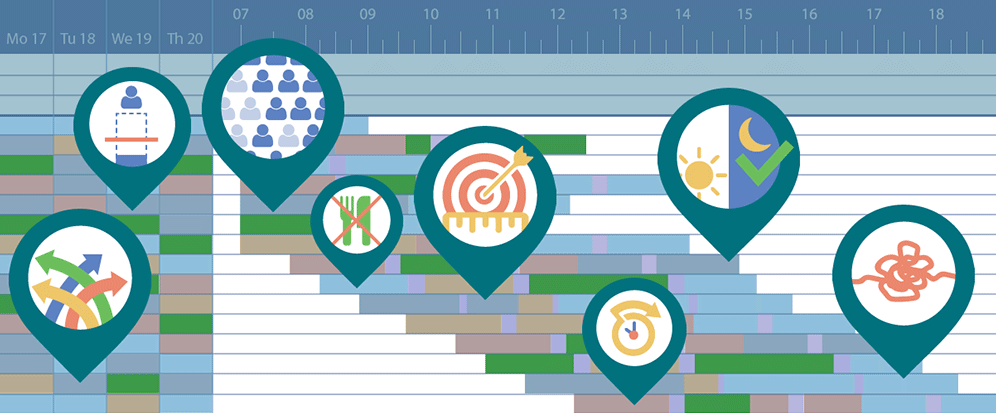Workforce optimization, workforce management, and workforce engagement management. WFO, WFM, and WEM. Three acronyms that you hear more and more nowadays. They sound deceptively similar and they are often used interchangeably. Clearly, they are all something to do with the workforce. But what exactly do they do? What are the differences between them? And what value do they add?
Definitions
The relationship between workforce management, workforce optimization, and workforce engagement management is explained in this diagram:

In reality, the boundaries between WFM, WEM, and WFO are a little blurred. For example, workforce management can include elements of workforce engagement management and workforce analytics. That's why they overlap in the diagram. But the diagram is hopefully a useful tool for the purposes of this post.
Workforce Management (WFM)
Workforce management is about optimizing the deployment of the most valuable - and costly - resource in every business: the employees. The goal of WFM is to find the perfect balance between the three forces at work in every organization: customers, employees, and the business. Always having plenty of employees on hand is great for customer experience, but it runs the risk of making your business unviable. Putting the employee first may make your company a great place to work, but if the customer experience is awful and staffing costs are too high, that’s not sustainable either. Trying to cut costs by reducing headcount without considering the impact on customers and employees is a recipe for disaster, too. The goal of WFM is to simultaneously improve outcomes for customers, employees, and the business.
WFM includes
- Forecasting future workload based on historical trends and business intelligence
- Capacity planning that drives hiring and training to cover the anticipated scale of the business
- Scheduling to match supply and demand for staff as closely as possible, as often as possible while taking into account skills, labor laws, employment contracts, and other constraints
- Intraday management, enabling you to take swift and effective corrective action to defend your KPIs
Whether you’re running a contact center, a warehouse, or any other business with varying demand, WFM ensures you have the right people in the right place at the right time. It helps you avoid periods of understaffing, which lead to poor customer service and employee burnout. And it helps you reduce wasted labor costs by avoiding periods of overstaffing.
Workforce Engagement Management (WEM)
WEM goes beyond managing your workforce – it’s about actively engaging them. Disengaged employees tend to be demotivated and deliver a poor customer experience. They are more likely to have high levels of absenteeism. They are more likely to exhibit quiet quitting behavior, and ultimately resign. These behaviors are not just bad for the morale of colleagues and bad for customer service. They cost your organization real money. Staff turnover is costly. According to The Society of Workforce Planning Professionals, it costs between $10,000 and $20,000 to replace an employee.
WEM includes
- Listening to the voice of the employee, e.g. surveys
- Enabling employees to have a say about their working time by self-scheduling, shift bidding, or availability management
- Letting employees book time off or swap shifts on a self-service basis
- Giving employees visibility of their own performance
WEM is about involving employees in the efficient operation of the business. It has the potential to create a win-win culture and reduce the damaging effects of disengagement. WEM focuses on fostering a positive, motivating environment where employees feel valued, heard, and invested in the company’s success.
The term 'workforce engagement management' is relatively new. It was coined by some software vendors in response to the media buzz about the importance of employee engagement. In fact, good WFM applications have always included powerful functionality for WEM. For example, Peopleware introduced shift swapping and bidding in 2005 as part of its scheduling suite - long before employee engagement was as prominent as it is today. Nowadays, many tools include features that consider employee preferences and people-centric metrics in WFM processes.
Workforce Optimization (WFO)
Workforce optimization includes everything in WFM and WEM and adds functionality to measure, manage, and improve individual employee performance. WFM is about making sure the right number of people are working when you need them. WEM is about making them invested in their work. Workforce optimization is about also ensuring that they are as effective as possible while they are at work.
WFO includes
- Interaction recording, e.g. recording of all or a sample of calls in a contact center
- Interaction analytics, e.g. finding occurrences of certain words, phrases, or other events within calls or emails
- Performance management, e.g. monitoring KPIs and metrics, gamification
- Quality management, e.g. scoring of calls
- Coaching and training, e.g. self-paced e-learning
The goal is to make sure your employees aren’t just there – they’re delivering their best work.
Implementing WFO
To implement workforce optimization, you don’t need to buy a single monolithic application suite from one vendor. That’s good news, because you probably don’t need all the elements of WFO at the same time; the need for WFM or QM may be most urgent, for example. You can purchase elements that match your unique requirements in each area, as and when you need them, and let modern integration functionality make them work together harmoniously.














